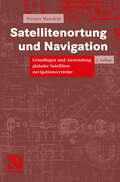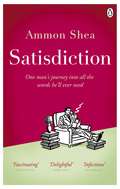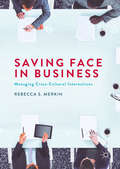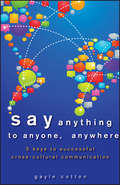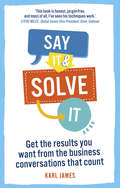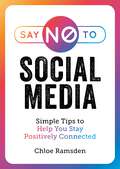- Table View
- List View
Satellite Systems for Personal and Broadband Communications
by E. Lutz M. Werner A. JahnA scientific overview of current and future satellite systems for mobile and broadband communications. In part I, the fundamentals of geostationary and non-geostationary satellite constellations and the related questions of communications technology are treated. Part II deals with satellite systems for mobile communications and treats several network features as well as their technology, regulation and financing. Part III is devoted to future satellite systems for broadband communications and explains the specialities of satellite communications, particularly on the basis of ATM and TCP/IP. An extensive survey on operating and planned satellite systems completes the book.
Satellite Systems for Personal Applications: Concepts and Technology (Wireless Communications and Mobile Computing #22)
by Madhavendra Richharia Leslie David WestbrookPresents the concepts, technology, and role of satellite systems in support of personal applications, such as mobile and broadband communications, navigation, television, radio and multimedia broadcasting, safety of life services, etc. This book presents a novel perspective on satellite systems, reflecting the modern personal technology context, and hence a focus on the individual as end-user. The book begins by outlining key generic concepts before discussing techniques adopted in particular application areas; next, it exemplifies these techniques through discussion of state-of-art current and emerging satellite systems. The book concludes by contemplating the likely evolution of these systems, taking into consideration influences and trends in technology, in conjunction with growing user expectations. In addition to addressing satellite systems that directly interact with personal devices, the book additionally considers those indirect applications where there is an increasing interest by individuals - notably, in remote sensing. As such, the book uniquely encompasses the entire gamut of satellite-enabled personal / end-user applications. Key Features: Broad scope - views satellite systems generically with regards to their applicability across a wide range of personal application areas Strong foundation in underlying concepts State-of-the-art system examples Review of trends in relevant areas of satellite technology Revision questions at the end of each chapter The book is suited to individuals, engineers, scientists, service providers, system operators, application developers and managers interested or involved in the use of satellite technology for personal applications. It should also hold interest for use in research institutes interested in promoting inter-disciplinary cross-fertilization of ideas, as well as by financiers, policy makers, and strategists interested in gaining a better understanding of this technology.
Satellite Systems for Personal Applications: Concepts and Technology (Wireless Communications and Mobile Computing #18)
by Madhavendra Richharia Leslie David WestbrookPresents the concepts, technology, and role of satellite systems in support of personal applications, such as mobile and broadband communications, navigation, television, radio and multimedia broadcasting, safety of life services, etc. This book presents a novel perspective on satellite systems, reflecting the modern personal technology context, and hence a focus on the individual as end-user. The book begins by outlining key generic concepts before discussing techniques adopted in particular application areas; next, it exemplifies these techniques through discussion of state-of-art current and emerging satellite systems. The book concludes by contemplating the likely evolution of these systems, taking into consideration influences and trends in technology, in conjunction with growing user expectations. In addition to addressing satellite systems that directly interact with personal devices, the book additionally considers those indirect applications where there is an increasing interest by individuals - notably, in remote sensing. As such, the book uniquely encompasses the entire gamut of satellite-enabled personal / end-user applications. Key Features: Broad scope - views satellite systems generically with regards to their applicability across a wide range of personal application areas Strong foundation in underlying concepts State-of-the-art system examples Review of trends in relevant areas of satellite technology Revision questions at the end of each chapter The book is suited to individuals, engineers, scientists, service providers, system operators, application developers and managers interested or involved in the use of satellite technology for personal applications. It should also hold interest for use in research institutes interested in promoting inter-disciplinary cross-fertilization of ideas, as well as by financiers, policy makers, and strategists interested in gaining a better understanding of this technology.
Satellite Technology: An Introduction
by Andrew F Inglis Arch LutherSatellite Technology, Second Edition is a complete update of this popular handbook exploring the world of communication satellites. It will help broadcast professionals and students fully understand these indispensable telecommunications tools. Written in easy-to-understand language, this book covers topics ranging from theories of satellite operation to practical instructions for the initial set-up of mobile earth stations. The second edition has been thoroughly updated to include: · the impact of rapid advances in digital technology,· the mass deployment of digital DBS systems,· new initiatives in satellite design, and· changes in regulations.
Satellite Technology: An Introduction
by Andrew F Inglis Arch LutherSatellite Technology, Second Edition is a complete update of this popular handbook exploring the world of communication satellites. It will help broadcast professionals and students fully understand these indispensable telecommunications tools. Written in easy-to-understand language, this book covers topics ranging from theories of satellite operation to practical instructions for the initial set-up of mobile earth stations. The second edition has been thoroughly updated to include: · the impact of rapid advances in digital technology,· the mass deployment of digital DBS systems,· new initiatives in satellite design, and· changes in regulations.
Satellitenfrequenzkoordinierung: Regelungen - Linkdesign - Systemtechnik
by Hans Dodel René WörfelFunksysteme bilden zunehmend die Grundlage von Kommunikation, privat ebenso wie in Industrie und Wirtschaft. Von WLAN bis zur Satellitenkommunikation müssen die Kommunikations-, Navigations- und Rundfunksatelliten und ihre Bodenanlagen national und international regulatorisch koordiniert werden. Das Buch beschreibt anschaulich das Prozedere einer Funkanmeldung, erörtert Beispiele von Satellitenprojekten und zeigt Wege auf, wie das endliche Spektrum effektiv genutzt werden kann, damit auch in Zukunft weitere Systeme zugelassen werden können.
Satellitenkommunikation
by Hans Dodel Sabrina EberleSatellitenkommunikation im Aufbruch: Fernsehverteilung, multimediale Geschäftskommunikation, Kommunikation per Handy. Der umfassende Einblick in alle relevanten Aspekte: ausführliche Grundlagen, die Bedeutung unterschiedlicher Satellitenbahnen, Koordinierung von Frequenzen. Die Autoren rechnen eine Streckenbilanz durch, stellen die relevanten Verfahren der Codier-, Chiffrier- und Modulationsverfahren dar und behandeln Vielfachzugriffsprotokolle.
Satellitennavigation
by Hans Dodel Dieter HäuplerDie Ortung und Navigation mit Hilfe von Satelliten steht an einem Wendepunkt. Mit dem europäischen Satellitennavigationssystem GALILEO ist die Entscheidung für ein eigenes europäisches Navigationssystem gefallen, das neue Maßstäbe setzt und der europäischen Wirtschaft nachhaltige Impulse geben kann. Wie funktioniert GALILEO? Warum brauchen wir dieses System? Welche Anwendungen werden damit möglich? Diese Fragen beantwortet das Buch und stellt den aktuellen Wissensstand zu diesem Thema dar, einschließlich der mathematischen Grundlagen.
Satellitenortung und Navigation: Grundlagen und Anwendung globaler Satellitennavigationssysteme (Studium Technik)
by Werner MansfeldDie Navigation zur See und in der Luft ist durch das Satellitenortungssystem GPS grundlegend revolutioniert worden. Auch in Straßenverkehrsleitsystemen ist GPS mittlerweise zu einem tragenden Element geworden. Anwendungen in Geodäsie, Bauwesen und Sicherheitstechnik runden die Anwendungsvielfalt ab. Das Buch beschreibt Grundlagen und Anwendungen.
Satellitenortung und Navigation: Grundlagen und Anwendung globaler Satellitennavigationssysteme
by Werner MansfeldDie Navigation zur See und in der Luft ist durch das Satellitenortungssystem GPS grundlegend revolutioniert worden. Auch in Straßenverkehrsleitsystemen ist GPS mittlerweise zu einem tragenden Element geworden. Anwendungen in Geodäsie, Bauwesen und Sicherheitstechnik runden die Anwendungsvielfalt ab. Das Buch beschreibt Grundlagen und Anwendungen. Die 2. Auflage berücksichtigt das neue europäische System GALILEO. Text und Bilder wurden aktualisiert.
Satiric TV in the Americas: Critical Metatainment as Negotiated Dissent
by Paul AlonsoIn a time of global infotainment, the crisis of modern journalism, the omnipresence of celebrity culture and reality TV, and the colonization of public discourse by media spectacle and entertainment, postmodern satiric media have emerged as prominent critical voices playing an unprecedented role at the heart of public debate. Indeed, satiric media has filled gaps left not only by traditional media but also by weak social institutions and discredited political elites. In Satiric TV in the Americas, Paul Alonso analyzes the most influential satiric TV shows in the Americas--focusing on shows in Argentina, Peru, Ecuador, Mexico, Chile and the United States--in order to understand their critical role in challenging the status quo, traditional journalism, and the prevalent local media culture. Alonso illuminates the phenomenon of satire as resistance and negotiation in public discourse, the role of entertainment media as a site where socio-political tensions are played out, and the changing notions of journalism in today's democratic societies. Introducing the notion of "critical metatainment" -- a transgressive, self-referential reaction to the process of tabloidization and the cult of celebrity in the media spectacle era -- Satiric TV in the Americas is the first book to map, contextualize, and analyze relevant cases to understand the relation between political information, social and cultural dissent, critical humor, and entertainment in the region. Evaluating contemporary satiric media as a consequence of the collapse of modernity and its arbitrary dichotomies, Satiric TV in the Americas also shows that, as satiric formats travel to a particular national context, they are appropriated in different ways and adapted to local circumstances, with distinct consequences.
Satiric TV in the Americas: Critical Metatainment as Negotiated Dissent
by Paul AlonsoIn a time of global infotainment, the crisis of modern journalism, the omnipresence of celebrity culture and reality TV, and the colonization of public discourse by media spectacle and entertainment, postmodern satiric media have emerged as prominent critical voices playing an unprecedented role at the heart of public debate. Indeed, satiric media has filled gaps left not only by traditional media but also by weak social institutions and discredited political elites. In Satiric TV in the Americas, Paul Alonso analyzes the most influential satiric TV shows in the Americas--focusing on shows in Argentina, Peru, Ecuador, Mexico, Chile and the United States--in order to understand their critical role in challenging the status quo, traditional journalism, and the prevalent local media culture. Alonso illuminates the phenomenon of satire as resistance and negotiation in public discourse, the role of entertainment media as a site where socio-political tensions are played out, and the changing notions of journalism in today's democratic societies. Introducing the notion of "critical metatainment" -- a transgressive, self-referential reaction to the process of tabloidization and the cult of celebrity in the media spectacle era -- Satiric TV in the Americas is the first book to map, contextualize, and analyze relevant cases to understand the relation between political information, social and cultural dissent, critical humor, and entertainment in the region. Evaluating contemporary satiric media as a consequence of the collapse of modernity and its arbitrary dichotomies, Satiric TV in the Americas also shows that, as satiric formats travel to a particular national context, they are appropriated in different ways and adapted to local circumstances, with distinct consequences.
Satisdiction: One Man's Journey Into All The Words He'll Ever Need
by Ammon SheaAmmon Shea was ten when he first discovered the joy of reading a dictionary rather than using it to look a word up. Little did he imagine that one day he would spend over $1,000 and sacrifice an entire bookcase and a whole year to the twenty volumes that make up the king of all reference books: The Oxford English Dictionary.It was a year that changed his life, not least when he fell in love with a lexicographer. In this hilarious, personal and fascinating book, with a chapter for each letter of the alphabet, Shea introduces us to hundreds of words he discovered that deserve to see the light of day again, and explains why. Want to know the word for the area on your back that you can't reach to scratch (acnestis)? Or the term for the smell of earth just after a rainstorm (petrichor)? Or perhaps you're just looking for the word to describe that feeling of saying enough (satisdiction). This book is all you need.
Saudi Arabia in the Anglo-American Press: Covering the Kingdom during the 20th Century (Routledge Studies in Middle Eastern History)
by Abdullah F. AlrebhThis book provides an in-depth analysis of authority structures in Saudi Arabia during the twentieth century, as presented in two leading Western newspapers, The London Times and The New York Times. Beginning with a history of Saudi Arabia – from the building of the Kingdom in 1901, when Ibn Saud left his exile in Kuwait to recover Riyadh back from Al-Rasheed’s rule, until the death of King Fahd in 2005 – the author then outlines the theoretical framework of the book, specifically Weber’s original conception of authority. Weber’s notion of authority as having three types – traditional, charismatic, and rational-legal – is applied to an analysis of the two newspapers over the course of the twentieth century. A timeline is devised to aid this analysis, based on significant turning points in Saudi history, including Ibn Saud’s declaration of the Kingdom in 1932 and King Faisal’s assassination in 1975. Ultimately, this analysis discloses the many ways in which conceptions of authority in the Middle East were presented to Western audiences, whilst illuminating the political agendas inherent to this coverage in the UK and the US. This book is vital reading for anyone interested in Saudi Arabian history, Western perspectives of the Middle East, and the sociology of media.
Saudi Arabia in the Anglo-American Press: Covering the Kingdom during the 20th Century (Routledge Studies in Middle Eastern History)
by Abdullah F. AlrebhThis book provides an in-depth analysis of authority structures in Saudi Arabia during the twentieth century, as presented in two leading Western newspapers, The London Times and The New York Times. Beginning with a history of Saudi Arabia – from the building of the Kingdom in 1901, when Ibn Saud left his exile in Kuwait to recover Riyadh back from Al-Rasheed’s rule, until the death of King Fahd in 2005 – the author then outlines the theoretical framework of the book, specifically Weber’s original conception of authority. Weber’s notion of authority as having three types – traditional, charismatic, and rational-legal – is applied to an analysis of the two newspapers over the course of the twentieth century. A timeline is devised to aid this analysis, based on significant turning points in Saudi history, including Ibn Saud’s declaration of the Kingdom in 1932 and King Faisal’s assassination in 1975. Ultimately, this analysis discloses the many ways in which conceptions of authority in the Middle East were presented to Western audiences, whilst illuminating the political agendas inherent to this coverage in the UK and the US. This book is vital reading for anyone interested in Saudi Arabian history, Western perspectives of the Middle East, and the sociology of media.
Saving Face in Business: Managing Cross-Cultural Interactions
by Rebecca S. MerkinThis book explains the subtle maneuvers of what researchers call “facework” and demonstrates the vital role it plays in the success or failure of cross-cultural interactions. Building on Geert Hofstede’s seminal research on cultural dimensions, Merkin synthesizes more recent research in business, communication, cross-cultural psychology and sociology to offer a model for better understanding facework. Additionally, Merkin’s model shows how particular communication strategies can facilitate more successful cross-cultural interactions. The first book of its kind to focus on the practical aspects of employing face-saving, it is a needed text for academics, students, and business professionals negotiating with organizations from different cultures.
Saving the Media: Capitalism, Crowdfunding, And Democracy
by Julia CagéJulia Cagé explains the economics and history of the media crisis and offers a solution: a nonprofit media organization, midway between a foundation and a joint stock company, supported by readers, employees, and innovative financing such as crowdfunding. Her business model is inspired by a central idea: that news, like education, is a public good.
The Savvy Academic: Publishing in the Social and Health Sciences
by Seth J. SchwartzThis approachable guide meets health and social sciences scholars at their level--either as a reference text or as an enchanting but practical read--and walks them through each stage of their academic publishing journey. Drawing on a wealth of examples from his own experience mentoring others and publishing 300+ articles, Dr. Schwartz engages early, mid-, and senior-level professionals as well as graduate students and postdoctoral fellows alike, to demystify each stage of the writing and publishing process. Employing a reader-friendly, accessible voice, Dr. Schwartz's style captivates readers across disciplines, with a refreshing, can-do perspective. Before diving in, the author relates his own personal story in scholarly publishing, inviting all academics to unlock the high-impact writer within. The next set of chapters tackle the nuts and bolts of the academic publishing process, with basics such as topic selection, data analysis for publication, writing preparation, drafting and editing manuscripts, and journals submissions. The book advances into more innovative topics that can be simultaneously intimidating and rewarding, including recruiting and collaborating with coauthors, developing a network, navigating the peer review process, publishing nonempirical papers, getting creative with rejected manuscripts, foraying into Open Access and fee-based publishing, and even how to publish a book or book chapter. Designed as a digital mentor, The Savvy Academic is the ultimate tool for students, fellows, and scholarly professionals of a broad range of experiences in the health and social sciences who are looking to launch or elevate their scholarly publication career.
The Savvy Academic: Publishing in the Social and Health Sciences
by Seth J. SchwartzThis approachable guide meets health and social sciences scholars at their level--either as a reference text or as an enchanting but practical read--and walks them through each stage of their academic publishing journey. Drawing on a wealth of examples from his own experience mentoring others and publishing 300+ articles, Dr. Schwartz engages early, mid-, and senior-level professionals as well as graduate students and postdoctoral fellows alike, to demystify each stage of the writing and publishing process. Employing a reader-friendly, accessible voice, Dr. Schwartz's style captivates readers across disciplines, with a refreshing, can-do perspective. Before diving in, the author relates his own personal story in scholarly publishing, inviting all academics to unlock the high-impact writer within. The next set of chapters tackle the nuts and bolts of the academic publishing process, with basics such as topic selection, data analysis for publication, writing preparation, drafting and editing manuscripts, and journals submissions. The book advances into more innovative topics that can be simultaneously intimidating and rewarding, including recruiting and collaborating with coauthors, developing a network, navigating the peer review process, publishing nonempirical papers, getting creative with rejected manuscripts, foraying into Open Access and fee-based publishing, and even how to publish a book or book chapter. Designed as a digital mentor, The Savvy Academic is the ultimate tool for students, fellows, and scholarly professionals of a broad range of experiences in the health and social sciences who are looking to launch or elevate their scholarly publication career.
Say Anything to Anyone, Anywhere: 5 Keys To Successful Cross-Cultural Communication
by Gayle CottonThe five steps to successful selling, negotiating, and managing multi-culturally Say Anything to Anyone, Anywhere gives readers five simple key guidelines to create rapport and organize strategies for success across different cultures. This book teaches to be proactive, not reactive, in your cross-cultural communications and shows how to use simple rapport tools to create trust with the cultures you work with or travel to. Learn how to organize productive interactions in person, on the phone, and by email. Discover interpersonal communication skills and virtual strategies that build strong relationships. Offers quick, accessible examples and clear guidelines about how to create an understanding between cultures Gives tips and strategies on how to communicate without offending Author Gayle Cotton is a Emmy Award Winner and a distinguished, highly sought after speaker, corporate trainer, and executive coach. This step-by-step guide to cross-cultural business will help you build strong relationships and manage successfully, no matter the cultural differences.
Say Anything to Anyone, Anywhere: 5 Keys To Successful Cross-Cultural Communication
by Gayle CottonThe five steps to successful selling, negotiating, and managing multi-culturally Say Anything to Anyone, Anywhere gives readers five simple key guidelines to create rapport and organize strategies for success across different cultures. This book teaches to be proactive, not reactive, in your cross-cultural communications and shows how to use simple rapport tools to create trust with the cultures you work with or travel to. Learn how to organize productive interactions in person, on the phone, and by email. Discover interpersonal communication skills and virtual strategies that build strong relationships. Offers quick, accessible examples and clear guidelines about how to create an understanding between cultures Gives tips and strategies on how to communicate without offending Author Gayle Cotton is a Emmy Award Winner and a distinguished, highly sought after speaker, corporate trainer, and executive coach. This step-by-step guide to cross-cultural business will help you build strong relationships and manage successfully, no matter the cultural differences.
Say It and Solve It: Get the results you want from the business conversations that count
by Karl JamesKarl’s knowledge makes his voice in this territory unique and hugely readable.”Dave Lewis, President, Personal Care, Unilever Why are the most important conversations the most difficult to handle? You know you have to have them, but still you put them off. And you want them to go well but you don’t know how to make sure they do. How do you prepare? What words should you use? How do you make your point without getting too nervous, tongue-tied or upset? And how are you going to solve the problem that needs addressing without upsetting someone? Say It and Solve it will coach you in the ten expert skills that peace negotiators, mediators and therapists use to take on even the most challenging situations and make every conversation count. You’ll discover:· Fascinating insights into how conversations really work: when to listen, when to talk and when to shut up!· How to avoid the most common mistakes that everyone makes.· The ten most powerful skills you need to tackle any conversation in any situation.· Expert guidance on handling tricky conversations in real-world, workplace situations. Stop putting off those tricky conversations and start talking (and listening) your way to solutions and success.
Say It and Solve It: Get the results you want from the business conversations that count
by Karl JamesKarl’s knowledge makes his voice in this territory unique and hugely readable.” Dave Lewis, President, Personal Care, Unilever Why are the most important conversations the most difficult to handle? You know you have to have them, but still you put them off. And you want them to go well but you don’t know how to make sure they do. How do you prepare? What words should you use? How do you make your point without getting too nervous, tongue-tied or upset? And how are you going to solve the problem that needs addressing without upsetting someone? Say It and Solve it will coach you in the ten expert skills that peace negotiators, mediators and therapists use to take on even the most challenging situations and make every conversation count. You’ll discover: · Fascinating insights into how conversations really work: when to listen, when to talk and when to shut up! · How to avoid the most common mistakes that everyone makes. · The ten most powerful skills you need to tackle any conversation in any situation. · Expert guidance on handling tricky conversations in real-world, workplace situations. Stop putting off those tricky conversations and start talking (and listening) your way to solutions and success.
Say It Well: Find Your Voice, Speak Your Mind, Inspire Any Audience
by Terry SzuplatWhether you're delivering a heartfelt toast or eulogy, giving a presentation at work, or speaking up for change, this comprehensive guide gives you the tools you need to become a confident and compelling speaker, communicator, and leader in your work and in life.Drawing on the life-changing lessons he learned from his time in the White House, leading speechwriter Terry Szuplat shows you how to:• Communicate clearly and confidently in any situation• Create an emotional connection with your audience• Adopt a new mindset to help overcome your anxieties• Use the power of storytelling to win over any audienceFull of practical tips, fascinating psychological research and never-before-heard insights and advice from conversations with President Obama, this book will transform the way you approach speaking in public forever.
Say No to Social Media: Simple Tips to Help You Stay Positively Connected
by Chloe RamsdenAre you familiar with FOMO? Do you often fall prey to the mindless scroll? Is the pressure of likes, follows and notifications getting you down? Although social media is a big part of modern life, using it can often leave us feeling drained, unfocused and unhappy – but it doesn’t have to be that way! This book has everything you need to put you back in the driving seat. With 100 practical tips, from switching off to curating positive feeds, you’ll find it easy to take the first steps towards a happier online life.







